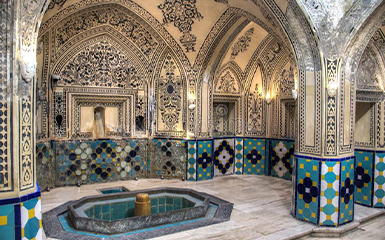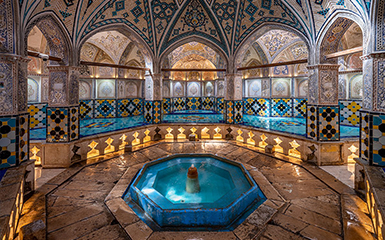Ardabil
Arg-e Bam
Abyaneh
Babak Castle
Behistun
Chogha Zanbil
Dasht-e Lut
Golestan Palace
Isfahan
Imam mosque
Kashan
Kharanaq
Mashhad
Masuleh
Meymand
Pasargadae
Naqsh-e jahan
Naqsh-e Rostam
Persepolis
Rayen Citadel
Saint Thaddeus
Saint Stepanos
Shiraz
Shushtar
Sultan Amir Ahmad
Tabriz
Takht-e Soleyman
Tehran
Tower of Silence
Yazd
Sultan Amir Ahmad hammam

Sultan Amir Ahmad hammam is a historical bathhouse, which was named after Sultan Amir Ahmad was the grandson of the ninth Shia Imam, Imam Javad. This hammam is a unique example of a public bathhouse in the history of Persia, and is probably unrivaled in its decorations and architecture. The Sultan Amir Ahmad Bathhouse is one of the National Monuments of Iran with an area of 1102 m2. There are also other famous hammams such as Fin Garden, Gozar-No, Abdol Razzagh Khan, Muhtasham in Kashan.
Public hammams existed in cities during all Islamic periods. In fact, we can say that the number of baths was more than the number of mosques. Hammam of Sultan Amir Ahmad belong to the Seljuk era. However, a part of these public baths, which is called "Sarbineh" (changing room), was built in the Qajar era.
The obvious signs of the destructive earthquake of 1771 on this structure testify to its antiquity dating back to the Seljuk era. Some believe that the current building was built on the ruins of the old public bathhouse during the Qajar era, around 1875, and a small public bathhouse was added to it.
A hammam is considered one of the complex architectural structures because of the principles it must follow. One of the interesting facts about them is that they are built lower than ground level to conserve internal heat and save energy.
Sultan Amir Ahmed Hamam has magnificent decorations and is unique in terms of decorations. Plasters attract the attention of every visitor. Bas-reliefs on the lime surface are considered one of the beautiful decorations of Persian architecture. In this building, a 17-layer restoration, an indication of its antiquity, was discovered.
Turquoise and golden tiles, seven-floor plaster and very special architecture have made the Sultan Amir Ahmed Hammam one of the most outstanding examples of Iranian Bath Architecture. The arched ceiling, fascinating mosaics and murals are the hallmarks of this bath. The water requirement of this bath is provided from two grounding wells, and water pipes made of terracotta were used to transport the water. Colourful window panes known as “Gol-Jaam” on the ceiling or walls are eye-catching.

